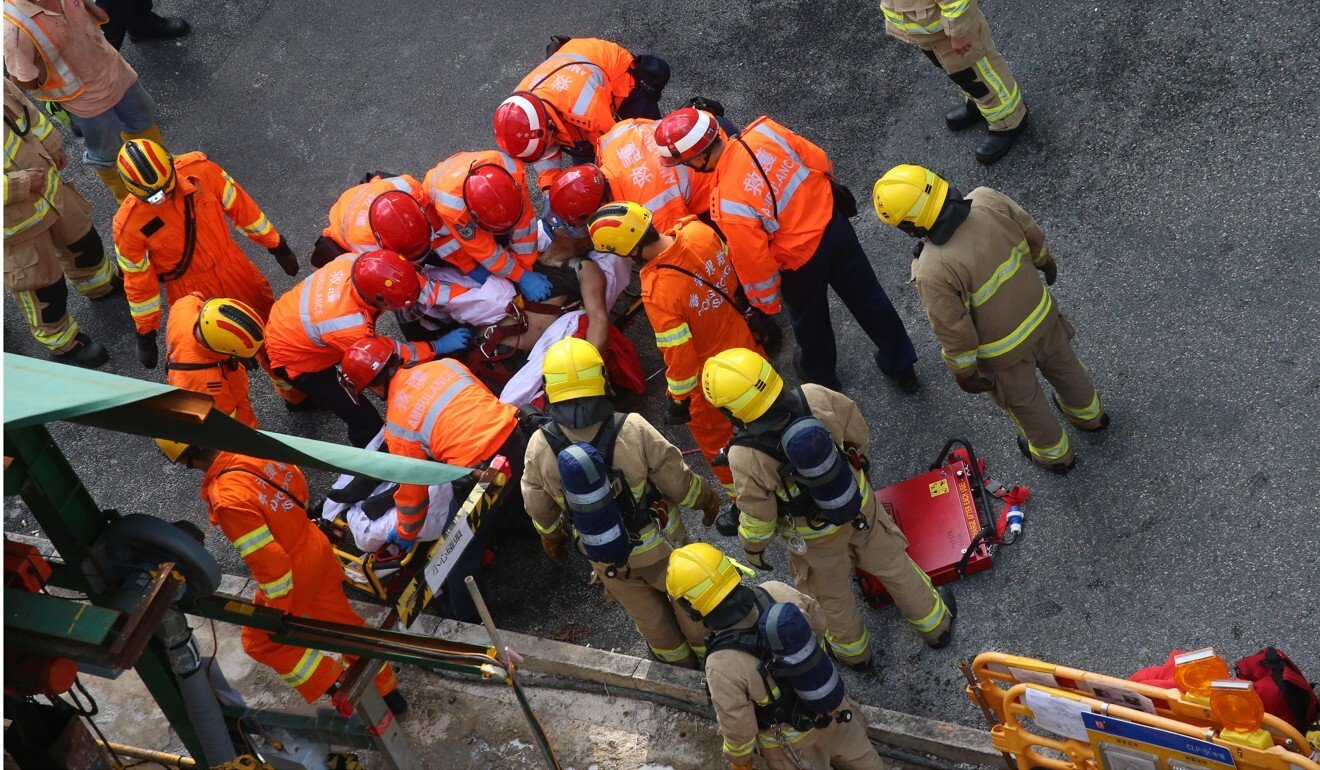
Hong Kong construction firms cleared over death of three workers in flooded tunnel
- Kum Shing Construction and two subcontractors found not guilty of 14 occupational safety charges over fatal industrial accident in Hung Hom in 2017
- The three men were killed after entering hand-dug tunnel five metres below ground that became filled with sewage from unknown source
Three Hong Kong construction companies have been cleared of failing to provide a safe workplace on a site where three workers drowned in a flooded tunnel three years ago.
Kum Shing Construction and two subcontractors were on Friday found not guilty of 14 occupational safety charges over a fatal industrial accident in Hung Hom on July 10, 2017, when CLP Power was laying underground cables.
Three men – Cen Canrong, 23, Fock Kam-chau, 49 and Wu Jianming, 48 – were killed after entering a hand-dug tunnel five metres below ground on the CLP Power site which suddenly flooded with sewage. The cause of death was inhalation of hydrogen sulphide and drowning.
Four companies and two staff members faced 21 summonses alleging that they had failed to provide five workers with safe plant and a system of work as well as failing to take reasonable care of the employees.

But Kowloon City Court sided with the defence in concluding that the contractors could not have reasonably foreseen the influx of a large volume of sewage – the source of which remains unclear – or the collapse of the tunnel face to formulate and implement appropriate procedures.
The court also ruled that the contractors did not have to answer to three summonses of failing to ensure that only qualified workers could enter the confined space, as the Labour Department confirmed that “the three deceased workers were certified to work in the tunnel”.
Site supervisor Lau Sze-hing and project engineer Ng Wan-po were also acquitted of failing to take reasonable care of the health and safety of the workers.
But the three contractors were found guilty of failing to maintain a register of workers’ personal particulars and medical information.
Three workers die as sewer burst fills Hong Kong tunnel
The main contractor was further convicted of a second summons for failing to tell the commissioner for labour of the specific location of the site – at the junction of Gillies Avenue South and Baker Street – within seven days of commencing work.
Each of these offences carries a maximum fine of HK$10,000 (US$1,282).
Kum Shing was fined HK$11,000, while its subcontractor Cheer Top Civil Engineering and secondary subcontractor Fu Ka Engineering & Construction were each fined HK$6,000, to be paid within two weeks.
Fu Ka, which had employed the three deceased workers, said it had stopped carrying out underground work since the accident, while the other two companies indicated they had enhanced their supervision to avoid an over-reliance on subcontractors.
The verdict came three days after Cen’s dependant, Tam Hoi-yan, sued Kum Shing and Fu Ka for an unspecified sum of damages as she accused the companies of negligence and breach of duty.

Deputy Magistrate Eric Yao Kwok-sun said the present case was not about identifying the cause of the accident or to apportion blame among the defendants. All except Kum Shing had no previous convictions.
An expert for the prosecution had described the scene of the accident as a “very difficult and high-risk site for tunnelling” as it was in an old reclamation area with highly congested underground utilities embedded in “loose and heterogeneous” ground.
Its high groundwater level also meant that tunnelling works had to be carried out below the water table, and workers had to be careful to avoid breaking fills.
At least 60 cubic metres (35 cubic feet) of sewage was estimated to have flooded into the 90-metre-long (295-foot) tunnel, which measured 1.4 metres (4.5 feet) in diameter, carrying hydrogen sulphide, which is produced in water that has been stagnant for a long time.
Hong Kong accident victim files HK$6 million suit over ‘malicious prosecution’
But the source remains uncertain, as the Drainage Services Department cannot confirm the sewage came from its pipes. The Water Supplies Department found no damage or leakage from its surrounding pipes.
While it was not disputed that the contractors did not have an emergency response team on site, the magistrate – who called the rescue chaotic – believed that was not a systemic flaw posing a risk to workers. That was because the particular site was a small one in the city centre, just minutes from the nearest fire station.
Yao also found there had been no significant change in the tunnel’s conditions that required contractors to carry out a fresh assessment and make recommendations to ensure workers’ safety.

